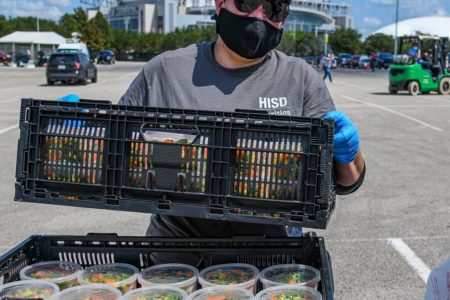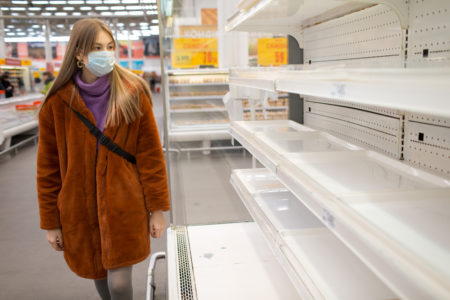Share On Social!
A lack of access to healthy, nutritious foods has harmed countless minorities for years.
This problem has only gotten worse during the coronavirus pandemic.
One in 10 Black and Latino families struggle with food insecurity, which is being without reliable access to a sufficient quantity of affordable, nutritious food, according to a recent report from the Census Bureau.
While different nonprofits and businesses have made attempts to help, wide-reaching gaps remain to make significant headway in food disparities.
“We are seeing families every week, and, unfortunately, the need is not going to go away because these issues were here before COVID,” Antonio Santos, co-founder and executive director of the Gage Park Latinx Council in Chicago, told Block Club Chicago. “We are also seeing families who were in a rough patch from a layoff because of COVID.”
“I think that speaks volumes to the level of food insecurity our community is seeing.”
Update 3/22/21: COVID-19 is rapidly accelerating food insecurity for Latinos, according to a recent study from Latina researchers at UC Merced (updates embedded in story below).
Communities of Color, Food Insecurity, and COVID-19
The pandemic has worsened many of the historic inequities affecting Latinos and other minorities.
Food insecurity is one of the most significant problems among these.
Before the pandemic, “14.3 million American households were food insecure with limited or uncertain access to enough food,” according to Feed America.
While it might take years to understand the impacts fully COVID-19 had on food insecurity, the initial findings aren’t looking good, according to the organization’s recent “The Impact of the Coronavirus on Food Insecurity” report.
“The Coronavirus (COVID-19) pandemic is impacting vulnerable households in various ways. Many food-insecure individuals have characteristics that put them at a higher risk for severe illness associated with COVID-19,” Feeding America states. “Workers who have service occupations or work in the leisure and hospitality industry are more likely to be food insecure and are at risk of further hardship as many businesses have been forced to close and lay off staff.” 
Still, this is just one factor among numerous complications impacting minority health.
A recent study from the University of Michigan highlights these substantial difficulties.
“Higher case and death rates were also seen in areas that had higher rates of measures that aren’t included in the standard Social Vulnerability Index, such as obesity, mass transit use, food insecurity and adults who lack health insurance,” researchers say.
U.S. Latinas are especially facing harm, according to a recent study published by Latina researchers Denise D. Payán, Karina Díaz Rios, A. Susana Ramírez, and Maria-Elena De Trinidad Young, all of UC Merced.
“During the coronavirus disease 2019 (COVID-19) pandemic, mass unemployment and loss of income contributed to rapid increases in food insecurity in the United States,” Payán and her colleagues wrote in the Journal of the Academy of Nutrition and Dietetics. “Latino households (18.5% of the population) have especially faced multiple health, social, and economic vulnerabilities.
“Latinas have been particularly hard hit by the pandemic’s economic crisis.”
As shelter-in-place orders were implemented across the country, Latinas saw widespread job-loss — 24% of whom lost their job. This is compared to Latino men who suffered an 18% drop in employment.
Now, roughly 57.1% of Latinas have reported a loss of a job and 11% have remained unemployed.
This has accelerated food insecurity in Latino homes.
For example, Payán and her colleagues wrote how “45% of Latino households in Los Angeles reported serious problems affording food compared with only 6% of White households.”
“Beyond documenting food inequalities, there is an urgent need to examine and understand how food-insecure households and individuals are coping and to address structural barriers that impede access to food and nutrition assistance among populations at high risk for malnutrition and diet-related health disparities,” they wrote.
This issue is affecting Latinos all over, too.
One Austin, Texas, resident gave an insight into what it’s actually like to struggle with social issues, including food insecurity.
“It makes you vulnerable when you don’t have access to fresh foods when you don’t have access to health care when you don’t have access to public transportation. You have to risk it all to get out there and get something for your babies,” Gloria Vera Bedolla told ABC’s Austin affiliate KVUE. “It’s worse. The issues are exacerbated.”
What Leaders Across the US are Doing to Help
Some groups are working tirelessly to help their neighbors.
These include:
- The city of Atlanta recently opened the world’s largest food forest that will house “2,500 pesticide-free edible and medicinal plants.”
- In Florida, the Latino Coalition of Tampa Bay identified food-insecure households and connected them to local businesses and faith groups to provide support.
- Chicago’s Gage Park Latinx Council has run initiatives to get food insecure households groceries, even for undocumented residents.
- The city of Austin, Texas, is working with Red Cross to distribute “meals ready to eat” in disadvantaged areas of the city following winter storms.
- The United Way of the Mohawk Valley is giving away 1,700 boxes packed with recipes and fresh and frozen ingredients to residents of Utica, New York (13% Latino).
- In July 2020, New York created a policy that requires supermarkets and grocery stores to donate excess food to charity. The rule goes into effect June 21, 2021.
While some communities are doing their part to assist food-insecure Americans, legislators and leaders can take more significant action. 
“Should unemployment and poverty increase to the level of the Great Recession, 9.9 million more people may experience food insecurity,” Feeding America states. “In a more extreme scenario, the number of food-insecure individuals could rise by 17.1 million. Demand for charitable food assistance has increased and is expected to continue to increase for the foreseeable future.”
It’s a fact that people of color have been the most impacted by COVID-19 impacts.
But rural whites have also suffered a lack of government action over the past year, according to Dr. Renuka Tipirneni, the Michigan study’s senior author.
“While the first [COVID] surge was mainly in urban areas with high percentages of Black and Latinx residents, as time went on, some of highest rates of cases and deaths were in rural counties with predominantly white populations,” Tipirneni said in a statement. “But across the board, we find the areas hardest-hit by the disease were linked by higher rates of social disadvantage.”
This only goes to show that across social, race, and class lines, food insecurity is impacting those who already were experiencing issues prior to the outbreak of COVID-19.
Despite a lack of thorough intervention, especially for America’s vulnerable communities, from the political leadership over the past year, some communities are stepping up to help those lacking healthy, nutritious food.
Still, not everyone is getting help, which why Latinos and all Americans can urge their representatives at the local, state, and federal levels to provide greater support.
“Where’s the City? Where’s the County? Where are our commissioners? Where are our representatives? You’re taking our money. Our tax money. We’re paying our bills,” Gloria Vera Bedolla told ABC’s Austin affiliate KVUE.
What Else Can Be Done to Address Food Insecurity among Latinos?
More than anything, Latinos and all Americans must play a role in changing this dangerous landscape.
“These findings highlight that underlying inequality and social disadvantage, and its role in promoting the spread of coronavirus, is a problem that affects all of us, no matter where we live,” Michigan University’s Tipirneni said in a statement. “This evidence contradicts the perception that COVID-19 mostly affects just one set of people in one kind of area.”
Payán and her UC Merced colleagues had a few recommendations, too:
- In nutrition counseling and education, screen routinely for food insecurity using brief screening tools available in English and Spanish.
- Understand individual-level factors impacting Latinas’ diets and ability to secure nutritious food (culturally preferred foods, eating behavior, etc.).
- Understand system-level factors that mediate Latinas’ access to nutritious food (targeted marketing, food assistance awareness and barriers to participation, especially those related to nutrition and immigration policy, etc.).
- Test the effectiveness of a food prescription program for food-insecure clients, and better connect people to existing community resources.
See all their recommendations, including federal-level action.
“Advocate to mitigate and address policy barriers for racial/ethnic groups and immigrant communities in state and federal legislative and regulatory processes,” Payán and the researchers wrote. “Advocate for expanded eligibility and increased utilization of federal nutrition assistance programs (i.e., SNAP and the Special Supplemental Nutrition Program for Women, Infants, and Children).”
What You Can Do to Address Food Insecurity in Your Community
In the meantime, if you’d like to continue making a difference in your community’s nutrition—especially food insecurity—you can download a Salud America! Health Equity Report Card.
The report card will show you how many local children live in poverty and food deserts, how many have low food access, and how many get SNAP food benefits. Then you can compare it to your state and to the country.
Email your Health Equity Report Card to community leaders, share it on social media, and use it to make the case to address food insecurity where help is needed most!
GET YOUR HEALTH EQUITY REPORT CARD!
Explore More:
Healthy FoodBy The Numbers
1
Supermarket
for every Latino neighborhood, compared to 3 for every non-Latino neighborhood



